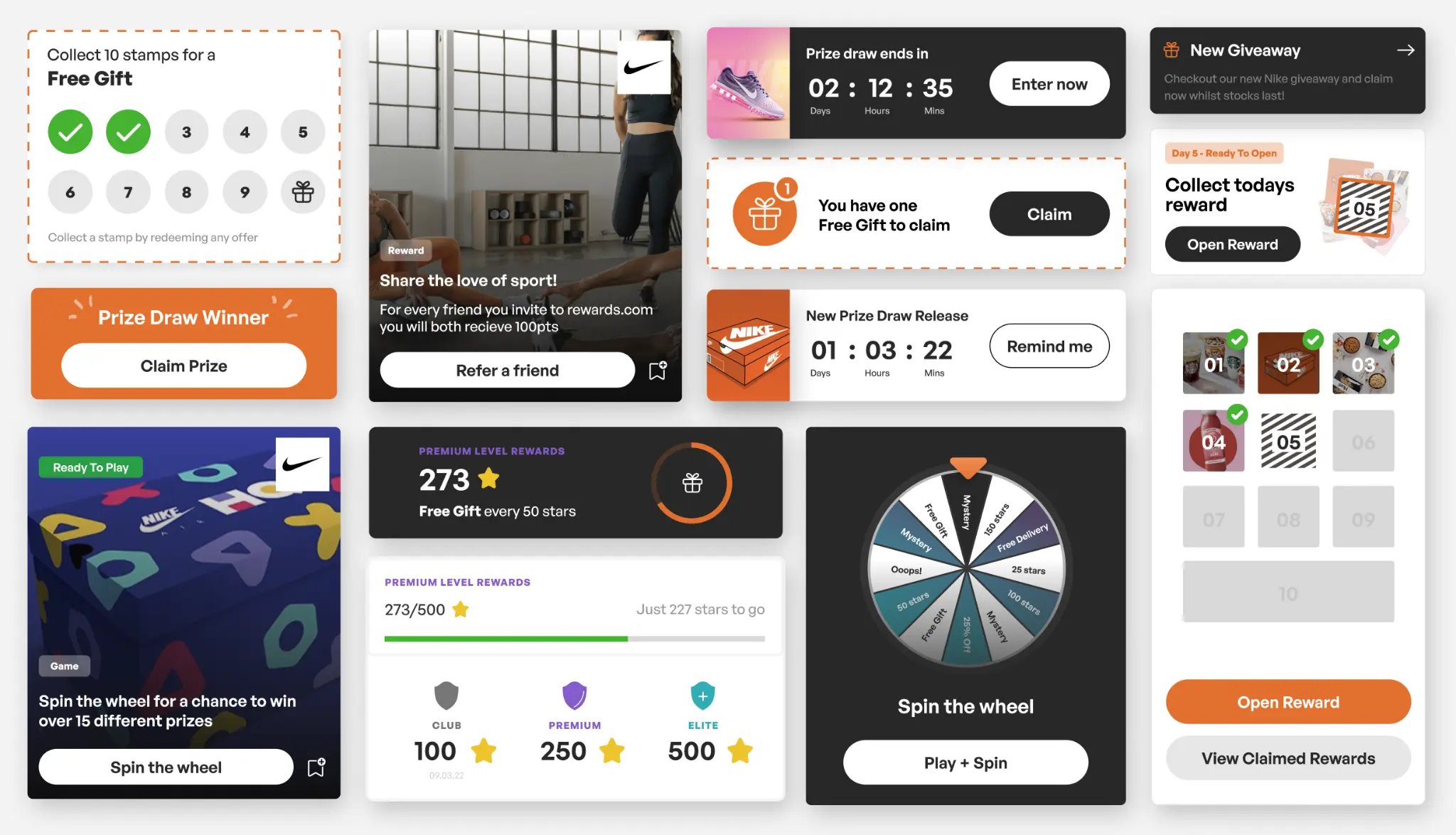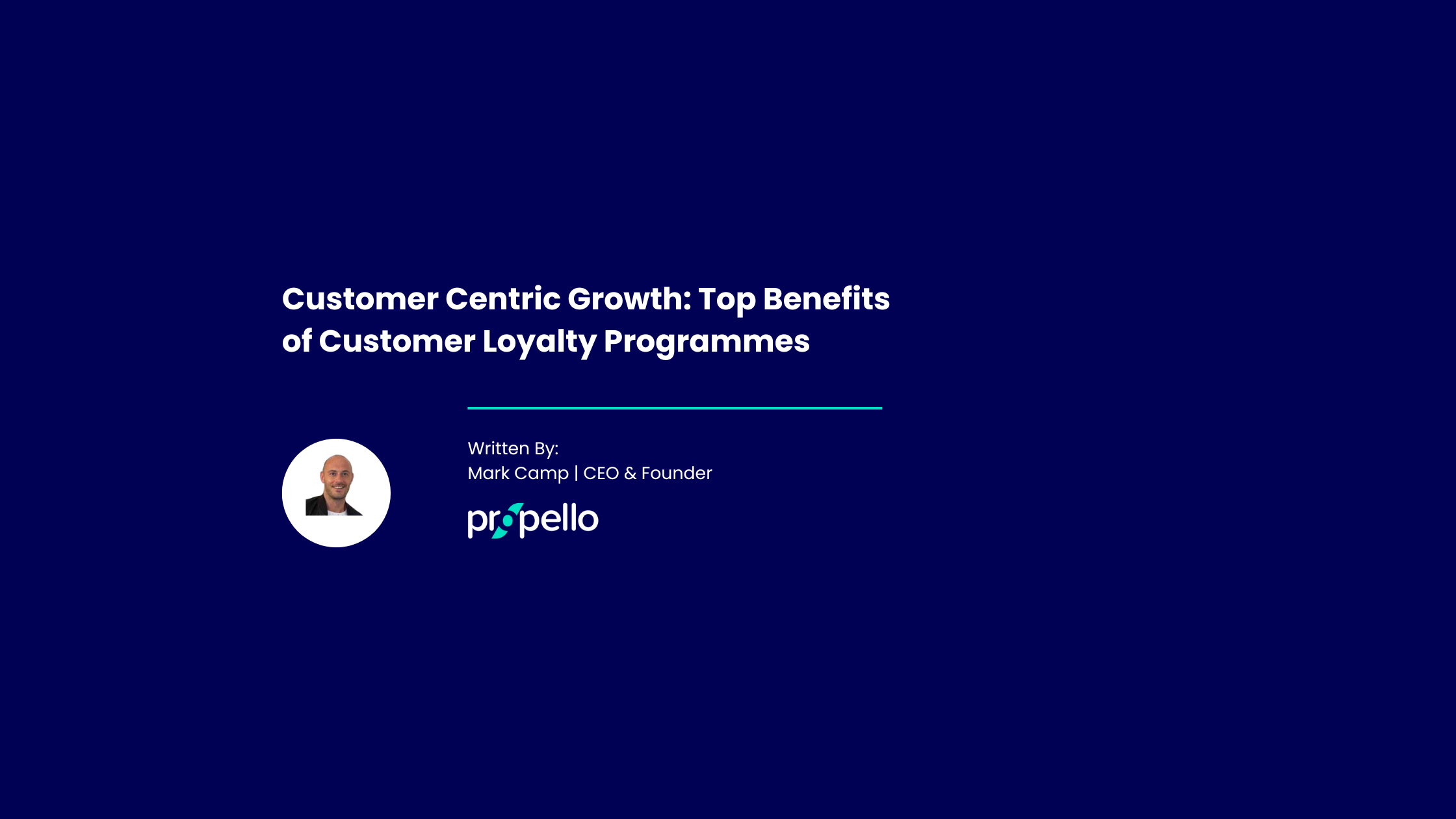From increased revenue to consumer engagement, join us as we explore the many benefits of loyalty programmes beyond everyday transactions.
There’s no denying the transformative impact of customer loyalty on modern businesses.
However, as technology gives the customer a wider range of options and marketplaces become increasingly competitive, some organisations face an uphill task to establish loyalty among their customers.
This is where loyalty programmes make a difference. Beyond simple benefits like discounts, loyalty programmes provide a whole ecosystem of benefits to enhance the customer experience.
Contents:
Key Takeaways
-
Loyalty programmes boost customer retention and increase customer lifetime value (CLV).
-
Effective loyalty programmes create brand advocates, encouraging powerful word-of-mouth marketing.
-
Points-based loyalty systems and tiered programmes motivate higher purchase frequency and basket value.
-
Loyalty programmes provide valuable customer data, enabling personalised experiences and targeted marketing.
-
Exclusive access and perks in loyalty programmes differentiate brands from competitors.
-
Gamification elements in loyalty programmes significantly increase customer engagement.
-
White-label loyalty solutions offer a cost-effective way to implement and scale programmes.
-
Loyalty programmes help businesses move away from price-based competition, focusing on customer relationships instead.
-
Successful loyalty programmes balance transactional rewards with experiential benefits to create emotional connections.
-
Regular programme audits and data analysis ensure loyalty programmes continue to deliver ROI and meet customer expectations.
The Growing Popularity of Loyalty Programmes
Customer loyalty programmes are strategic marketing tools designed to reward and incentivise repeat customers. They offer benefits like points, discounts, or exclusive perks to customers who frequently purchase from a business.
The primary purpose? To create long-term relationships with customers, encouraging them to choose your brand over competitors.
But what’s behind the popularity of loyalty programmes? Why do over 90% of businesses have one?
You've probably noticed that more and more companies now offer rewards cards, points systems, or exclusive member benefits. There's a good reason for this trend.
Loyalty programmes are revolutionising how businesses connect with their customers. These programmes do more than just offer freebies. They're powerful tools that boost your customer lifetime value and create passionate brand advocates.
When you reward your customers for their loyalty, you build a community of happy customers around your brand. And happy customers stay loyal.
In the modern world of endless consumer options, cultivating loyalty is critical. By investing in a loyalty programme, you're not just boosting short-term sales; you're laying the foundation for sustainable, customer-centric growth.
Back to contents
Types of Loyalty Programmes
Loyalty programmes come in various shapes and sizes, each designed to suit different business goals and customer preferences, and can deliver different benefits according to their use case.
Always on reward programmes
An always-on loyalty programme is a continuous rewards system that doesn't require customers to actively sign up or opt-in to participate. It automatically tracks customer purchases and behaviours, offering personalised rewards and incentives based on their ongoing interactions with your brand, creating a seamless loyalty experience
Points-based loyalty programmes
Perhaps the most common. Also know as earn & burn loyalty programmes, customers earn points with each purchase, which they can later redeem for rewards. It's simple and effective, encouraging repeat purchases.
Tiered loyalty programmes
Tiered loyalty programmes add an element of exclusivity. Customers climb to higher tiers by spending more, unlocking better perks. This structure motivates customers to increase their spending to reach the next tier.
Paid (VIP / Premium) loyalty programmes
These programmes like Amazon Prime, charge a membership fee. In return, you get access to a range of benefits. These programmes create a strong sense of customer commitment, and like a tiered programme a sense of exclusivity.
The right type of loyalty programme for you depends on your unique business model and goals. Consider your customers' preferences too. Some may love the gamification aspect of challenges to achieve higher rewards and tiers, while others might prefer a VIP programme, which gives access to exclusive benefits.
The best loyalty programme should feel like a natural extension of your customer experience, not an afterthought.
Download our guide which compares the benefits of different types of programmes and will help you match the best programme for your business.
Back to contents
10 Benefits of Loyalty Programmes for Brands
Still not sold on the importance of loyalty programmes? Let’s put those doubts to bed with key benefits to expect from a rewards programme.
1) Boosts revenue and retention
Boosting revenue and retention is at the heart of any successful loyalty programme. By focusing on keeping your existing customers happy, you're tapping into a goldmine.
Did you know you're 60-70% more likely to sell to an existing customer compared to only 5-20% for new prospects? That's a game-changer for your bottom line.
Take Starbucks, for example. Their renowned loyalty programme, Starbucks Rewards, not only keeps coffee enthusiasts coming back for their daily fix but also contributes to an impressive 16% annual growth in revenue.
2) Builds stronger customer relationships
But it's not just about short-term sales. These programmes build stronger customer relationships through personalisation, exclusive experiences, and surprise and delight rewards.
Customers, driven by the desire for unique experiences, become more loyal to a brand that provides a feeling of belonging to an exclusive community. A recent study found that 71% of customers will switch brands if they don’t get sufficient benefits.
Nike's loyalty programme, Nike Membership, goes beyond discounts. It offers access to member-exclusive products that are not available to the general public. These products may include limited-edition releases, early access to new collections, or special editions.
3) Differentiates a brand from its competitors
A well-crafted loyalty programme sets you apart from competitors and gives customers a compelling reason to choose you. When 78% of consumers say they're more likely to buy from a brand with a loyalty programme, you know you're onto something special.
4) Encourages word-of-mouth marketing
Happy customers don't just come back - they spread the word. Your loyalty programme members become your brand ambassadors, engaging in powerful word-of-mouth marketing that reaches potential customers through trusted recommendations.
Take airline loyalty programmes like Delta SkyMiles, which offer everything from free flights to airport lounge access. Such perks not only encourage repeat business but also turn customers into brand advocates.
5) Shows customers you appreciate them
By showing appreciation to your loyal customers, you're not just making them feel good - you're giving them a reason to stick around. This appreciation translates into long-term loyalty and repeat business.
Consider Sephora's Beauty Insider programme, where members receive personalised product recommendations and exclusive access to events. This not only boosts engagement but also creates a sense of community among beauty enthusiasts.
6) Motivates consumer behaviour
Loyalty programmes are also fantastic motivators of consumer behaviour. Whether it's through tiered structures or points systems, you can encourage customers to increase their spending and visit more frequently.
Over 83% of customers say that joining a loyalty programme makes them more likely to make repeat purchases.
It's a win-win: customers get more rewards, and you see higher average order values
7) Broad customer knowledge
Perhaps one of the most valuable aspects of loyalty programmes is the wealth of customer data they provide.
By analysing programme data, you gain deep insights into customer preferences and behaviours, allowing you to tailor your offerings and marketing strategies more effectively. 60% of customers will remain loyal to a brand after experiencing a personalised shopping experience.
Amazon Prime, for instance, uses customer data to enhance the overall shopping experience. The result? A seamless blend of personalisation and convenience that keeps customers coming back.
8) Effective cost optimisation
This data isn't just for show; it's a goldmine for cost optimisation and potential monetisation. Instead of relying on constant price cuts, you can focus on improving your value proposition and resource allocation. Plus, the insights gained can lead to new, targeted revenue streams.
9. Increased customer lifetime value (CLV)
Loyalty programme members typically bring in 12-18% more revenue annually than non-members. As customers engage more with your brand to earn rewards, their value to your business grows over time.
10. Reliable business metrics
Finally, loyalty programmes provide reliable metrics for your business. With measurable data on customer behaviour, you can track key performance indicators and make data-driven decisions to continually improve your customer experience.
One example is analysing spending patterns to identify customers who contribute significantly to your overall revenue. This insight then informs exclusive offers and personalised communication to further solidify loyalty among this valuable group.
Benefits of Loyalty Programmes for Customers
Now what about customers? What exactly do they gain from loyalty programmes? Ultimately, the more they get from your loyalty programme, the more likely they will stay with you and increase spend.
1) Savings and rewards
Customers earn points, discounts, or other rewards that often translate into significant savings over time, giving them more value for money. Whether it's cashback, free products, or discounted services, these perks make every purchase more rewarding.
2) Exclusive access and perks
Many programmes offer members early access to sales, exclusive products, or special events. This insider treatment makes customers feel valued and special. From preview shopping nights to limited-edition items, exclusive offerings create a sense of privilege that enhances the overall brand experience.
3) Personalised experiences
Tailored recommendations and personalised offers within loyalty programmes ensure that customers receive relevant content and promotions. This makes their shopping experience more enjoyable and efficient. It's like having a personal shopper who knows all their tastes and preferences.
4) A sense of fun!
Some loyalty programmes incorporate gamification elements like challenges, treasure hunts, achievement badges, or prize draws. A study found that gamification increases customer engagement by 60%.
These fun elements add excitement to the shopping experience, turning routine purchases into enjoyable, memorable adventures.

5) A feeling of belonging
Loyalty programmes create a sense of community among customers. Programme members become part of an exclusive group with shared interests. This sense of belonging grows as they connect on members-only forums, events, or social media groups to share experiences and feel part of something bigger than just a basic transactional relationship with a brand.
Overcoming the Common Challenges
Even the best-laid plans can hit snags. Let's tackle some common hurdles in loyalty programmes and how to overcome them. We’ve included this because you’re unlikely to realise the benefits of loyalty programmes if these aren’t managed or implemented effectively.
Upfront and Ongoing Costs
Building a loyalty programme isn't cheap. And running one can be a continuous investment. But don't let that scare you off.
Solution: Consider investing in a white-label loyalty solution. These ready-made platforms can significantly reduce your upfront costs and time to market.
White-label solutions offer a range of benefits:
- Quick setup: Launch your programme faster without building from scratch.
- Scalability: Easily add features as your needs grow.
- Lower maintenance: Benefit from regular updates without in-house IT resources.
- Customisation: Tailor the look and feel to match your brand.
With a white-label solution, you can focus on strategy rather than technology, making it easier to start small and scale up as you see results.
Read more on the build vs. buy debate.
Unrealistic Expectations
Expecting your loyalty programme to skyrocket sales overnight? That's a recipe for disappointment.
Solution: Set clear, achievable goals. Focus on long-term customer value rather than short-term spikes. Remember, building loyalty takes time.
Poor Communication
If your customers don't know about your programme or how it works, they can't engage with it.
Solution: Shout it from the rooftops. Use multiple channels to promote your programme. Make the benefits crystal clear and the sign-up process a breeze.
Inadequate Rewards
Offering lackluster rewards is a surefire way to lose customer interest.
Solution: Put yourself in your customers' shoes. What would excite you? Mix it up with a blend of always-on and long-term rewards. And don't forget about experiential perks—sometimes memories are worth more than material goods.
Lack of Data Utilisation
Collecting customer data but not using it? You're missing out on a goldmine of insights.
Solution: Invest in analytics tools (another area where white-label loyalty software shines) to make sense of your data. Use these insights to personalise offers, improve your product range, and enhance the customer experience.
Cost Mismanagement
Poorly managed programmes can quickly become a drain on resources.
Solution: Keep a close eye on your programme's finances. Regularly audit your rewards structure and adjust as needed. Remember, the goal is to create value for both your customers and your business.
By addressing these challenges head-on, you'll be well on your way to reaping the full benefits of your loyalty programme.
Loyalty Programmes — The Gift That Keeps on Giving!
Download our Customer Loyalty and Reward Programme guide to learn which type of loyalty programme works best for your business. Explore how nurturing loyalty can supercharge your ROI and drive sustained growth for your business.
FAQs
What is a loyalty programme and how does it work?
A loyalty programme rewards repeat customers with points, discounts or perks for purchases. Customers earn rewards based on spending, redeemable for benefits or offers. It aims to encourage customer retention and increase lifetime value through a structured reward system.
What are the main benefits of implementing a loyalty programme for businesses?
Loyalty programmes boost retention, increase revenue, gather customer data, encourage repeat purchases, differentiate brands, create advocates, personalise marketing, increase customer lifetime value, reduce acquisition costs and enhance customer experience. They foster long-term relationships and provide valuable insights for business growth.
How do loyalty programmes help increase customer retention?
Offering purchase incentives, creating emotional connections through personalised experiences, and providing exclusive benefits builds community and makes customers feel valued. They create barriers to switching, increase switching costs, and provide tangible reasons for customers to remain loyal.
Can loyalty programmes attract new customers as well?
Loyalty programmes attract new customers through referral incentives, word-of-mouth marketing, exclusive benefit appeal, reward curiosity, and sign-up bonuses. They can create buzz, differentiate the brand, and offer immediate value to potential customers, serving as a unique selling point in marketing efforts.
How do loyalty programmes impact the average order value (AOV) of customers?
Loyalty programmes often increase average order value by encouraging higher spending for rewards, offering tiered benefits, providing exclusive discounts on pricier items, and creating psychological motivation to maximise points or maintain status. They can prompt bulk purchases and upselling opportunities.
What types of rewards are typically offered in loyalty programmes?
Typical loyalty rewards include redeemable points for discounts, free products or services, cashback, exclusive sale access, early releases, service upgrades, personalised offers, partner benefits, experiential rewards, and charitable donations. The mix aims to provide both tangible and emotional value to members.
How do loyalty programmes contribute to customer data collection and analysis?
Loyalty programmes aid data collection by tracking purchases, preferences, and behaviour. This enables businesses to analyse spending patterns, segment customers, personalise offers, predict behaviour, identify high-value customers, and tailor products or services. It provides a comprehensive view of customer interactions and preferences.
How can loyalty programmes enhance customer engagement and advocacy?
Loyalty programmes boost engagement and advocacy by creating emotional connections, offering personalised experiences, fostering community through events, encouraging reward sharing, providing feedback platforms, and turning satisfied customers into brand ambassadors. They create multiple touchpoints for meaningful customer interactions and brand reinforcement.
What are some common types of loyalty programmes?
Common loyalty types include points-based, tiered, paid membership, value-based, coalition, gamified, cashback, and hybrid programmes. Each type suits different business models and customer bases, offering varied ways to reward loyalty and encourage desired customer behaviours.
How do businesses measure the success of a loyalty programme?
Businesses gauge programme success through enrolment rate, active member percentage, redemption rate, average order value, purchase frequency, customer lifetime value, Net Promoter Score, retention rate, ROI, and incremental revenue from members. These metrics assess overall programme effectiveness.
Mark Camp | CEO & Founder at PropelloCloud.com | LinkedIn

Mark is the Founder and CEO of Propello Cloud, an innovative SaaS platform for loyalty and customer engagement. With over 20 years of marketing experience, he is passionate about helping brands boost retention and acquisition with scalable loyalty solutions.
Mark is an expert in loyalty and engagement strategy, having worked with major enterprise clients across industries to drive growth through rewards programmes. He leads Propello Cloud's mission to deliver versatile platforms that help organisations attract, engage and retain customers.






.png)